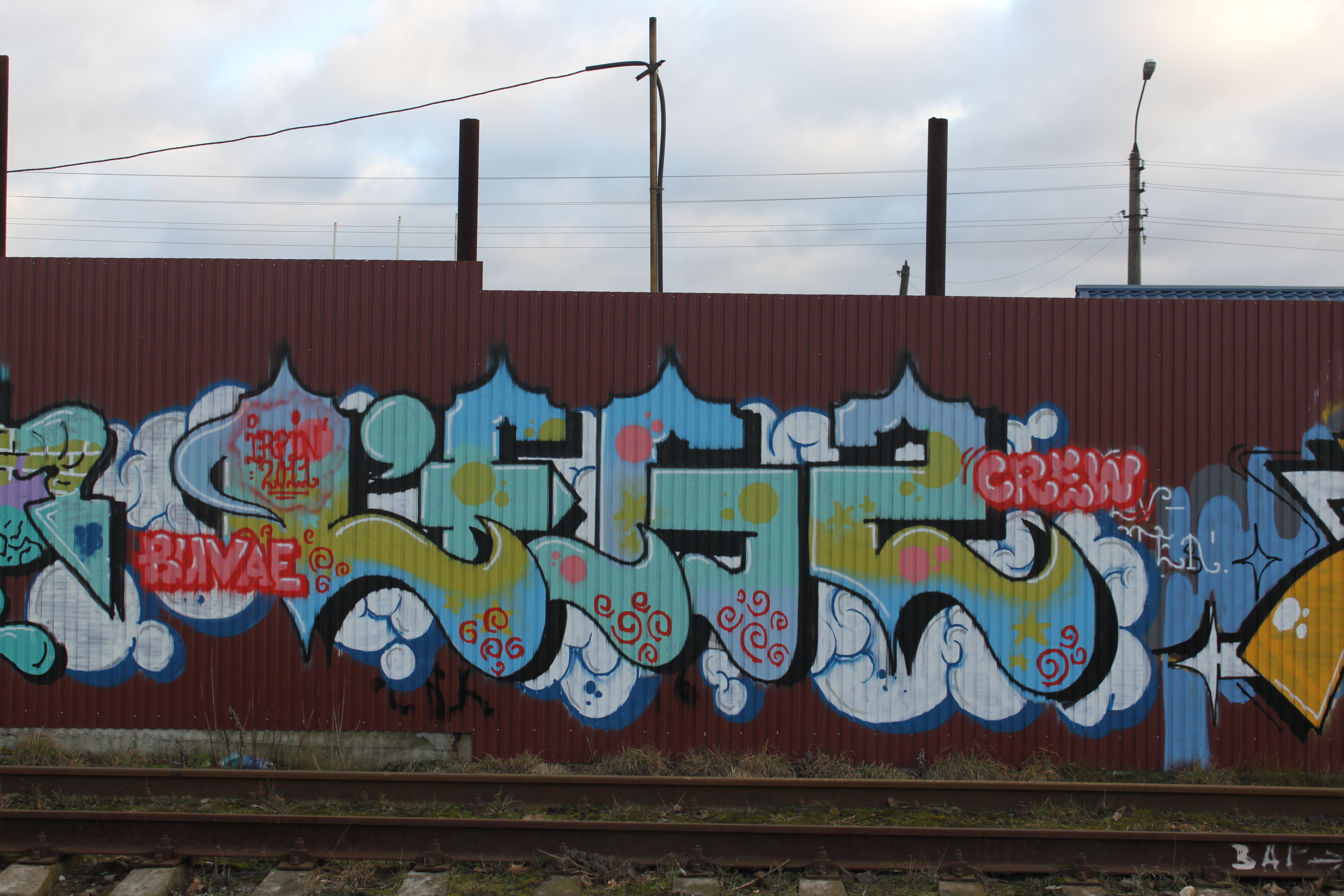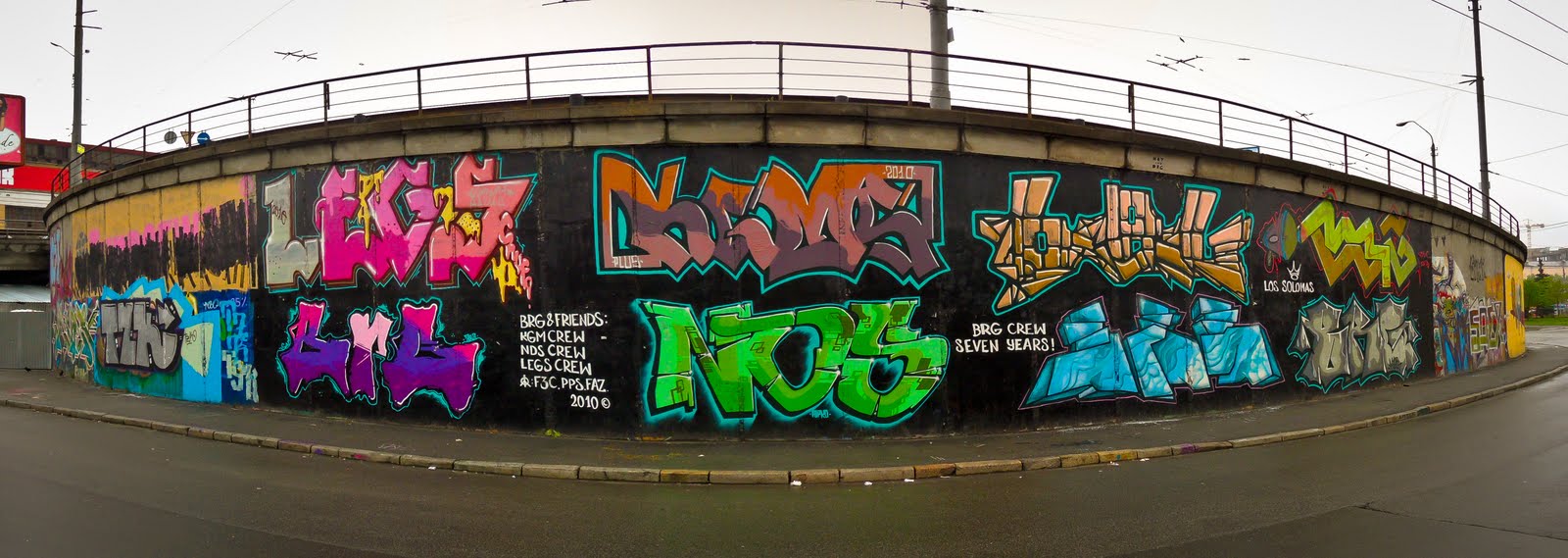
- •Iрпiнь – 2011 table of contents
- •Introduction 4
- •Iрпiнь – 2011 1
- •Introduction
- •1.1 What is graffiti?
- •1.2 Origins and the History of Graffiti
- •Part II
- •2.1 Contemporary trends of graffiti
- •2.2 Graffiti in Ukraine
- •2.3 Main styles of graffiti
- •2.3.1 Tagging
- •2.3.2 Wild style
- •2.4 Is graffiti art?
- •2.4.1 Why is graffiti considered art?
- •2.4.2 The graffiti art culture
- •2.5 Is graffiti vandalism?
- •2.6 Is graffiti legal?
- •Do you think graffiti should be:
- •Glossary of terms
- •Bibliography
- •Attachments
Part II
2.1 Contemporary trends of graffiti

Irpin. 2011
Graffiti is recognized by an increasing number of people in the art world as a form of modern, urban art. However, this recognition may also put this art form under threat as it is now losing the support of the authorities. The problem with graffiti is that it has been stigmatized because of the amount of illegal activity i.e. spraying where it is not permitted. Despite the fact that it has these associations there is still the recognition that modern graffiti is rapidly developing as a discernible contemporary art form.
Some graffiti artists have made their work or their pieces so distinctive that they can be recognized on sight as the author of a particular piece – just as artists like Picasso were distinguishable for their own contemporaries in a particular art movement.
Graffiti is a young art form and it is also a form that is mostly indulged in by young men – modern graffiti is often also associated with the musical rave of hip-hop and rap.
New forms of graffiti first emerged on the city streets of New York and have now developed from signatures to a much more intricate and rapidly establishing modern art form.
In its early days in New York graffiti was tolerated by both the public and the police and this helped the art form to grow and spread to other cities and countries across the world. From the graffiti subculture of disaffected and rebellious young men there has emerged an exciting and contemporary art form that is becoming known as modern graffiti.
The graffiti subculture is closely connected to the music subculture of hip-hop. These two things are sometimes so closely intertwined that those who engage in graffiti art are also engaged in hip-hop music, while the musicians may also be graffiti artists.
One problem with the rise of modern graffiti has been the indiscriminate use of other people’s property for their canvas (at least by some graffiti artists) and so various penalties have been put into practice (including the sale and use of spray paints) to try and stem the spread of graffiti.
It would be a pity if such legislation brought about an end to this art form altogether as more and more members of the established artistic community are recognizing the artistic merit of modern graffiti
Authority’s attitude to graffiti has given it an undertone associated with crime and drug use. This is an undertone that is untrue of the vast majority of graffiti writers. Moreover, graffiti is sometimes the creative outlet that prevents young people becoming involved with drugs and petty crime. Modern graffiti needs more recognition as an art form in its own right – which means that there should be some publicly funded means of using this particular type of creative expression.
2.2 Graffiti in Ukraine
Graffiti art is a new notion in Ukraine. Still unknown in the provinces, it is not completely understood in big cities.
Graffiti can debase the most imposing building and convey a variety of emotions and information. They can also annoy the hell out of people. Not long ago, a civic group called Veteran, composed mainly of elders, declared war on graffiti. Its activists believe that the Ukrainian capital looks much better “without any drawings and inscriptions on walls and fences.” In its statement, however, the group emphasized that they are not against professional artists “working miracles on the street.”
The biggest problem with graffiti today is that you can’t tell the difference between classic fence daubing and street art.

Kyiv. 2011
So what is graffiti art all about? It is as mentioned above a creative component of pop culture, or according to the scholarly definition, an avant-garde trend of the second half of the 20th century. Marking territories — painting a code name or stylized name on all stationary and mobile surfaces, which looks like Arabic to the uninitiated — has become popular in Kyiv over the past couple of years. Another graffiti trend using stencils is slowly making its appearance in Ukraine.
Graffiti in Ukraine exists in three main categories: names, politics, and love. The first group includes various depictions of a name (more often a nickname). These can be colorful compositions, covering entire walls, or kids’ daubing. The political category is made up of slogans and mottos (the kind that engulfed Ukraine during the presidential campaign). The love category includes inscriptions like Mike + Mary.
In New York City in the mid-1960s, where Graffiti originated, large numbers, initials, and anonymous nicknames started appearing on the outer and inner walls of subway cars. Before long, such drawings spread to railway tracks and structures.
The New York authorities regarded graffiti as a criminal phenomenon and fought it as best they could. They started by banning the sale of thick markers, then the most popular street artists’ implement, and then felt pens.
The Mayor’s Office in Kyiv proved to be smarter than its NYC counterpart of the 1970s: the municipal authorities didn’t even try to combat graffiti.
Psychologists hold a definite opinion on the issue. According to Olena Vlasova, an assistant professor at the Faculty of Social Psychology at Shevchenko National University, the only way to sort out the problem is legalizing graffiti: “A teenager is in the phase of individualization” and therefore tries to find other ways to express his individuality. A drawing on a wall in this case is an external material carrier of inner development. “Speaking of drawings, there is another psychological aspect. They are most often created by teenagers with artistic talent. However, creative perception, as any other creative product, is realized only when it finds social approval. In the West, they take a more civilized approach to graffiti. There, a gifted street artist may be invited to decorate a nightclub.”
Olena Vlasova believes that the city administration should pay more attention to street artists, all the more so as there are plenty of ugly walls in Ukrainian cities, and graffiti may be the only way to stop horrifying the populace and the mayor’s office.
“Social services could invite the city administration and teenagers to work on such ugly structures. We know that a phenomenon can be overcome by taking command of it,” says Olena Vlasova, “and graffiti are a serious social problem; it signifies not so much the defacing of buildings as the unwillingness of adults to help their children realize themselves. Socialization entails two sides and two generations, so graffiti only prove that one of the sides, the older generation, isn’t measuring up. Teenagers’ emancipation is declarative. They only say they want to be left alone; in reality, they need understanding and their behavior signals this need.”
According to prof. Mykhailo Chemberzhi, People’s Artist of Ukraine and rector of the Kyiv Children’s Academy of Art, this kind of creative activity has a right to exist provided it is done professionally and elegantly...and certainly in the context of general urban-planning constructions, to avoid disharmony. Still, graffiti is not art; this is a type of creative endeavor, whereas art is a qualitative category. This expert says that a phenomenon that occurs in a social environment, in this case on the street, must observe certain rules of the game.
